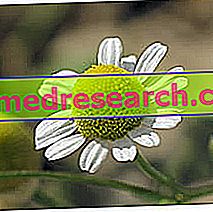
Scientific name
Matricaria recutita L., sin. Matricaria chamomilla L., Chamomilla recutita L.Family
Asteraceae (Compositae)Origin
Central-Southern EuropeSynonyms
Common chamomile
Used Parts
The drug present in the Official Pharmacopoeia is given by the dried flower headsChemical constituents
- Essential oil (alfabisabolol and its oxides, camazulene, guaiazulene, cerulene, farnesene);
- Flavonoids (apigenin, isoramnetin, quercetin, luteolin);
- mucilage;
- Cumarine (erniarina, umbrelliferone);
- Amine;
- Polysaccharides;
- Vitamins B1 and C;
- Sesquiterpene lactones (matricina, matricarina).
Chamomile in Herbal Medicine: Properties of Chamomile
Chamomile is used in therapy for its anti-inflammatory and antispasmodic properties on the smooth muscles of the digestive tract; it is therefore indicated in case of gastritis, enteritis, colitis, esophagitis and peptic ulcer.
Chamomile is also used as a mild sedative; furthermore, it is associated with healing, bactericidal and antifungal properties.
Common chamomile should not be confused with Roman chamomile, given its quite different properties.
Roman chamomile ( Anthemis nobilis ) is in fact equipped with aperitif and digestive properties.
Apart from the standardized and titrated extracts (which can be used correctly for pharmaceutical and herbal purposes), to alleviate the most common inflammatory symptoms affecting the digestive system, a home remedy consists of a concentrated infusion of flower heads (one soup spoon per cup of water) or in a short decoction, which also allows the extraction of polysaccharides.
For more information, read: Chamomile in Herbal Tea »
For external use, the chamomile extracts are recommended above all in products applied on inflamed, delicate, sensitive, irritated, acneic skin, with couperose or boils, thanks to the local anti-inflammatory, antimicrobial, healing and dermo-purifying properties.
Biological activity
The properties of which the chamomile is endowed are given by the essential oil (in particular, by the chamazulene and by the alpha-bisabolol contained in it) and by the flavonoids (among which apigenin stands out) present within it.
Thanks to the action of these compounds, the use of chamomile has been officially approved for the treatment of inflammations and irritations of various kinds and nature and for the treatment of inflammatory diseases of the gastrointestinal tract associated with spasms.
The anti-inflammatory properties of chamomile are attributable to apigenin and camazulene contained in its essential oil. In fact, camazulene is able to inhibit the synthesis of leukotriene B4 (a particular type of leukotriene involved in inflammatory processes); while apigenin is able to reduce leukocyte adhesion to endothelial cells that occurs during inflammation.
Alpha-bisabolol, on the other hand, is responsible for the effects that chamomile exerts on the gastrointestinal tract. In fact, this substance - which is found inside the essential oil - is able to reduce the proteolytic activity of pepsin at the gastric level, while flavonoids help reduce any inflammatory states.
The properties of chamomile, however, do not end there. In fact, numerous researches have been conducted on the other possible activities carried out by the flavonoids contained in it and, in particular, by the apigenin.
From the various studies carried out it emerged that apigenin is also capable of binding to the same receptor site as benzodiazepines, thus exerting a mild sedative and anxiolytic action.
Potential antitumor activity was also investigated in apigenin. In fact, studies have shown that topical application of apigenin can be useful in preventing the transformation of skin papillomas into carcinomas.
Chamomile against inflammation
As mentioned, thanks to the essential oil and flavonoids contained in it, chamomile can be successfully used in the treatment of phlogistic conditions of various kinds.
Chamomile is administered systemically to counteract inflammation of the gastrointestinal tract, the oropharyngeal mucosa and the upper airway.
When administered topically, on the other hand, chamomile is used as a remedy for inflammation of the mucous membranes, gingivitis and pulpits.
If used internally, chamomile can be taken as a 1: 4 liquid extract. The usual dose is 1-4 ml of product, to be taken three to four times a day.
If used externally, instead, you can prepare a solution for compresses through the infusion of two tablespoons of chamomile in hot water for about fifteen minutes.
Chamomile against gastrointestinal spasms
Thanks to the properties of the alpha-bisabolol and the flavonoids contained in chamomile, this plant can be used internally to treat gastrointestinal disorders associated with spasms.
Also in this case, the liquid extract of chamomile 1: 4 can be taken, at a dose of 1-4 ml from three to four times a day.
Alternatively, chamomile can be taken as an infusion.
Chamomile in folk medicine and homeopathy
In folk medicine, chamomile is used internally as a remedy for flatulence and diarrhea; while it is used externally to treat hemorrhoids, abscesses and acne.
In homeopathy, on the other hand, chamomile is used as a remedy for inflammation and gastrointestinal spasms, against inflammation of the upper respiratory tract and against dysmenorrhea.
Furthermore, chamomile is also used in homeopathic field to treat dentition disorders in infants and children and to treat painful conditions in general.
Chamomile is readily available in homeopathic preparations in the form of solutions or granules. The dose of product to be taken may vary depending on the homeopathic dilution that is used.
Side effects
In rare cases allergic reactions may occur due to the presence of sesquiterpene lactones, or there may be a paradoxical effect with the onset of nausea and insomnia (the latter condition may occur, above all, following the consumption of chamomile in high doses, or later to its abuse).
Pharmacological Interactions
Chamomile can interfere with the activity of drugs, such as:
- Cumarinic anticoagulants (such as warfarin), whose activity can be increased by the hydroxycumarins contained in chamomile.
- Benzodiazepines, since the apigenin contained in the plant is able to bind to the same receptor site as these drugs.
- Drugs or natural products with sedative action, as chamomile can increase its effects.
- Calcium channel blockers, statins and cisapride, as chamomile could alter its metabolism.
If you are taking any of the above mentioned drugs and / or if you suffer from certain diseases, before taking preparations based on chamomile, it is necessary to ask for the preventive advice of the doctor.
Contraindications
Due to the risk of onset of anaphylactic reactions, the intake of chamomile is contraindicated in individuals allergic to the same chamomile, to any of its components or to other plants belonging to the Compositae family.
Chamomile should be used with caution in pregnancy.



